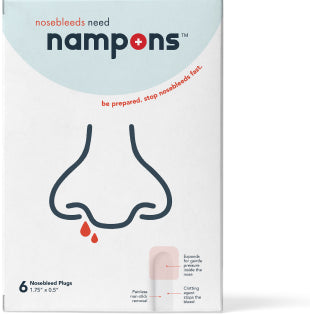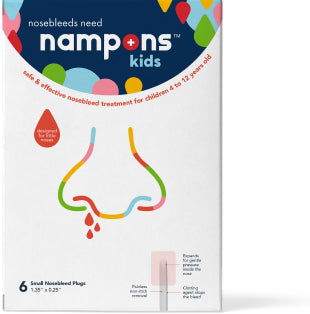This article was written by Dr. Derek Isenberg is an emergency physician in Philadelphia, Pennsylvania where he has practiced for the last 15 years. He attended medical school at the Tulane University School of Medicine and completed his emergency medicine residency at Hahnemann Hospital/Drexel University College of Medicine.
As an emergency physician, I am trained to deal with nosebleeds both at home and with advanced techniques in the emergency department. In my over 15 years of practicing emergency medicine, I have treated hundreds of nosebleeds of different etiologies. Nosebleeds are among the most common complaints that I treat in the emergency department.
Nosebleeds (medical term: Epistaxis) are a quite common occurrence among the general population. Nosebleeds are more common in the very young and very old. 95% of nosebleeds are from an area in the front of the nose, called Kieselbach's plexus. In this plexus, there are superficial blood vessels running just below the surface of the mucous membranes. If this area of the nose becomes cracked, irritated, or dry, nosebleeds can occur.
In this article, we discuss a variety of causes of nosebleeds and treatments for nosebleeds.
Causes
- Trauma: The most common cause of nosebleeds is nasal trauma, usually nose picking. Picking the nose results in irritation to the inside of the nostril where the blood vessels are located. Other types of trauma, such as getting hit in the nose while playing sports, can cause nosebleeds.
- Seasonal allergies: Seasonal allergies (hay fever) can cause damage to the inside of the nostrils. Allergies cause irritation, runny nose, and sneezing, all of which can irritate the lining of the nose causing it to bleed.
- Upper respiratory infection: Repeated blowing of the nose due to a cold or other viruses can cause irritation to the inside of the nose.
- Anticoagulants: Some people take anticoagulants (blood thinners) because of conditions like atrial fibrillation or strokes. These medications include apixaban (Eliquis) rivaroxaban (Xarelto), or warfarin (Coumadin). In addition, older patients may be on aspirin or clopidogrel (Plavix) to prevent stroke or heart attack. All these medications make the body more likely to bleed. Even minor irritation to the nose such as rubbing can cause the nose to bleed if you are taking one of these medications.
- Sleeping in a Dry Environment: Simply sleeping or spending time in a dry environment can cause the inside of the nose to crack, resulting in a nosebleed. Dry air is more common during the winter when people are sleeping with heaters. in addition, airplane flights can dry out the inside of the nose because of the dry recirculated air.
- Medical Conditions: Many medical conditions can make you more prone to nosebleeds. For example, patients with kidney disease or on dialysis are more likely to have nosebleeds. Some people have genetic problems, such as Von Willebrand disease, which causes their blood not to clot well.
Treatment
Most nosebleeds can be cared for at home with simple maneuvers.
- Direct Pressure: The mainstay of treatment for nosebleeds is direct pressure. Over 95% of nosebleeds come from the anterior or front part of the nose. This area is compressed by putting two fingers on either side of the soft part of the nose and holding pressure. Pressure should not be held over the bridge of the nose but over the front of the nose as this is from where the bleeding is most likely coming. Direct pressure should be held continuously for 20 minutes before removing the fingers. The most common mistake is removing the pressure before 20 minutes have elapsed.
- Nasal Tampons: Nasal tampons are soft swabs that are inserted into the nose. These tampons expand when exposed to blood or fluid. Nasal tampons work in two ways. First, by expanding inside the nostril, the tampon will put pressure on the bleeding arteries in the front of the nose. This pressure will help the bleeding to slow and the blood to clot. Second, nasal tampons contain a topical medication that helps the blood inside the nose to clot. These nasal tampons can be remarkably effective in stopping nosebleeds at home.
- Nasal Vasoconstricting Sprays: Another treatment that can be performed at home for nosebleeds is the use of nasal spray such as oxymetazoline (Afrin) or phenylephrine. Both sprays are available over the counter as decongestants. These medications work by constricting the blood vessels in the nose which slow or stop bleeding.
- Silver Nitrate: Silver nitrate sticks are available over the counter. Silver nitrate sticks look like long matchsticks. On the end of the sticks, they contain a chemical called silver nitrate. When applied to any active site of bleeding, silver nitrate will cauterize the area, causing a scab to form. The use of silver nitrate may cause irritation to the inside of the nose but should not be painful. After the use of silver nitrate, a grayish-white scab may form.
When to visit the Emergency Department for A Nosebleed:
Although most nosebleeds are not serious, there are warning signs that should prompt you to visit the emergency department. If the bleeding cannot be stopped after 20 to 30 minutes with direct pressure and other measures at home, you should proceed to the nearest emergency department. In addition, if you lose more than one cup of blood from your nose, you should also go to the emergency department. This could represent a life-threatening bleed that cannot be controlled with direct pressure. If you have any other associated symptoms with the nosebleed such as lightheadedness, dizziness, or the feeling of passing out, you should go directly to the emergency department. These symptoms may represent a large amount of blood loss.
What to expect in the emergency department:
When you arrive at the emergency department, it is likely that the ED provider will start by treating your nosebleed with some of the steps outlined above. For example, physicians may start by administering oxymetazoline or phenylephrine spray followed by direct pressure. The emergency providers may apply silver nitrate to stop the nosebleed. The doctors may also try a medicine called tranexamic acid (TXA). TXA helps blood clot and by preventing breakdown of the blood clot. TXA is usually administered by soaking a cotton pledget soaked in a TXA solution and then placed inside the nose for 15-20 minutes.
If the physician is unable to stop the bleeding with any of these methods, he or she will place nasal packing into the nose. Although there are many forms of nasal packing, the most commonly used type of packing is a plastic tampon that is placed into the nose and inflated with air. The pressure against the sides of the nose will stop the bleeding. Although nasal packing is uncomfortable, it is not painful. The packing will stay in for 3 to 5 days until you are able to see an otolaryngologist (ear, nose, and throat doctor). The nasal packing should be removed in the ENT doctor’s office in case there is further bleeding.
In exceedingly rare cases, if the emergency physician is unable to get your nosebleed to stop, he or she may need to contact a specialist for further intervention. An ENT doctor may need to take you to the operating room to directly visualize the source of the nosebleed. This procedure is performed under anesthesia and allows the ENT doctor to find the source of the bleeding and then stop the bleeding by directly tying or ligating an artery.
The emergency provider might also consult an interventional radiologist to assist with the nosebleed. An interventional radiologist would insert a small wire or catheter into an artery in the wrist or leg. The doctor would then advance the catheter to the blood vessels in the face and insert dye to show the source of the bleeding. The interventional radiologist would then put a small metal coil inside the bleeding vessel to cause the bleeding to stop. However, less than 1% of nosebleeds will require operative intervention.
Approximately 5% of nosebleeds are posterior nosebleeds, which means the bleeding is coming from the back part of the nose. Bleeding from the posterior part of the nose will not stop with direct pressure to the front part of the nose. If you are found to have a posterior nosebleed, the doctor will place a long nasal packing that extends to the back of your nose. In this case, you will be admitted to the hospital to monitor your breathing. In addition, you will be placed on antibiotics to prevent infection.
How Not to Treat a Nosebleed
- Do not pinch the bridge of the nose: The area of bleeding is most likely in the front of the nose. Pinching the back of the nose will only cause discomfort and not help stop the bleeding.
- Do not tilt your head backwards: This will not help stop the bleeding and will cause the blood to go down the back of your throat, even if the nosebleed is not a posterior bleed. The blood will irritate your stomach and cause you to gag and vomit.
- Do not stuff tissues in your nose: Stuffing tissues in your nose is ineffective and does not provide the pressure that you need to stop the nosebleed. You should directly compress the front of your nose and use vasoconstrictive sprays, and nasal tampons.
Prevention
There are many steps you can take to prevent nosebleeds.
- Make sure that you sleep in a moist environment. Heaters can dry out the air in the winter. Try sleeping with a humidifier in the room.
- When you are sick, use a saline nasal spray to help clear your mucus and sooth your nose. Saline sprays are available over the counter and will prevent your nose from drying out. These saline sprays will also help your nose to stay moist during an airplane flight.
- If you are prone to frequent nosebleeds, you can apply a thin layer of petroleum jelly to the inside of the nose. The jelly will prevent the nose from drying out and make the nose less likely to bleed.



